Nutrition Labels: What Information Is Required On Food Labels?
Understanding the essential components of food labels is crucial for ensuring that your products meet consumer expectations and regulatory requirements. Although, given that every product is made differently, access to comprehensive data becomes even more crucial.
In order to create a comprehensive food label, companies should begin with a statement of identity, also known as the food name. Following this, labels should include a serving size alongside the number of servings per package. It is crucial that these names and serving sizes accurately represent the food, as they greatly impact consumer perception of the product.
On the label should also be a comprehensive ingredient list and nutrition information. These details are mandatory as they can affect dietary choices, consumer decision-making, and health considerations.
Nutrition facts panels may include elements such as trans fat, saturated fat, total carbohydrates, total fat, total sugars, added sugars, dietary fiber, and number of calories. Additionally, important supplement facts are also commonly included such as vitamin D, calcium, potassium, vitamin C, and vitamin A.
What a product includes on its product labels is up to the brand, although it is critical that all nutrition claims are accurate and meet regulatory standards.
The FDA Can Detain Your Product for Inaccurate Nutrient Labeling
Inaccurate labeling is not just a minor oversight; it can lead to severe consequences such as FDA detention of your products. Whatever health claims you make on packaged foods must be backed up by data and specifications.
With the U.S. Food and Drug Administration (FDA) holding authority over nutrition fact labels, all products are at risk of being detained for failing to comply with established standards. To meet these standards, companies must constantly stay up to date with shifting regulations and product expectations.
Found in the Code of Federal Regulations, the Nutrition Labeling and Education Act (NLEA) gets even more granular, enforcing precise requirements companies must follow to ensure that consumers receive accurate and useful nutrition information.
These strict mandates put in place by the FDA require companies to not only pay close attention to detail but also back nutrient content claims up with data.
Many companies and food manufacturers face the consequences of not meeting nutrition facts labeling standards through aspects such as overestimating the presence of beneficial nutrients or underreporting allergens. Historically, products are recalled by the FDA as a result of such oversights, resulting in significant legal and financial repercussions.
To mitigate these risks, it is crucial that companies implement best practices, such as detailed speciation data inputs, ongoing compliance training, and regular audits. In doing so, companies will not only hold their products to a higher standard and build trust with consumers but also reduce regulatory risks.
Understanding Serving Sizes and Their Role in Labeling
Serving sizes are more than just numbers; they’re a guide for consumers and a regulatory focus that cannot be overlooked. Access to the serving of food on a particular food package will likely influence a consumer’s perception of the product’s healthiness and give consumers a reference amount of what should be consumed healthily per eating occasion.
Defined by the FDA, serving sizes and label information provide realistic portions of food that people typically consume to maintain a healthy diet, rather than idealized or recommended quantities. Having access to these dietary guidelines can greatly impact dietary patterns and what consumers deem as healthy portions.
With so many different products and ingredients, aligning the correct servings of food with FDA regulations can pose a huge challenge for food manufacturers.
Food packages must include label information that meets regulatory requirements while being intuitive for the consumer. Accurate serving sizes not only promote informed food choices but also foster trust in the product’s representation of balanced, healthy eating.
Allergen Labeling Requirements: Ensuring Safety for Consumers
Allergen labeling transcends mere regulatory compliance – it is a necessary aspect of food safety that projects the well-being of consumers. As of 2021, about 20 million Americans had food allergies – a number that has increased over the past three years. Providing allergen labels on food products provides these consumers with the extra information they need to consume products comfortably.
In the U.S., allergen labeling is mandated by the Food Allergen Labeling and Consumer Protection Act (FALCPA). The act requires companies to identify the following 8 major allergens on the information panel of food products: milk, eggs, fish, shellfish, tree nuts, peanuts, wheat, and soybeans.
Not only are companies required to lay out these active ingredients, but they are also required to state any potential cross-contamination risks. Failing to accurately label these allergens can pose huge consequences ranging from severe health risks for consumers to legal repercussions, all of which can ultimately hinder a company’s reputation in the market.
Marketing Claims vs. Labeling Regulations: Navigating the Fine Line
Marketing claims can be a powerful tool to differentiate your product, but they must be carefully balanced with strict labeling regulations to maintain compliance and consumer trust. While the right marketing claims may increase food sales, each claim must be truthful and align with regulatory standards. Marketing claims that fail to align with labeling regulations can lead to infractions and further legal risks.
Successful marketing claims are those that can be supported by scientific evidence or regulatory approval. This is important to ensure that product claims are valid and will build consumer trust.
This makes understanding existing regulatory boundaries and label formatting that are much more important for food manufacturers looking to avoid infractions and build consumer trust, and brand reputation.
The Power of Specification Data Management in Regulatory Compliance
In order to meet these complex regulatory requirements for nutrition labels companies must first gather their product data and specifications. By leveraging Specification Data Management (SDM) tools, companies can transform the complexity of regulatory compliance into a streamlined and reliable process.
As regulations shift and products change their ingredients, it is critical that data remains centralized and accessible to all team members. The adoption of Specification Data Management will empower companies to safeguard their products’ market presence while solidifying their reputation for reliability and consumer safety,
Specright, the leader in Specification Data Management, recently partnered with Trustwell to integrate with Genesis Foods, their industry-leading food formulation and nutrition labeling software. Trustwell is setting the standard for compliance, transparency, and quality in the food and supplement industries. Together, Specright’s SDM platform and Genesis Foods will provide a first-of-its-kind, end-to-end digital solution for food labeling.
The need for a single source of truth is more critical today than ever, as companies struggle to manage higher SKU counts, product and regulatory complexity, and changing consumer demands. This partnership with Specright and Trustwell will enable customers to seamlessly blend specification data, nutritional analysis, and label development to stay ahead of today’s ever-changing regulatory landscape.
To learn more, get a demo today.
Explore More Blogs
Get Started
With Specright’s Solution Suite, you can digitize, centralize, and link your specification data to drive efficiencies, intelligence, traceability, and collaboration within your organization and across your supply chain network.




